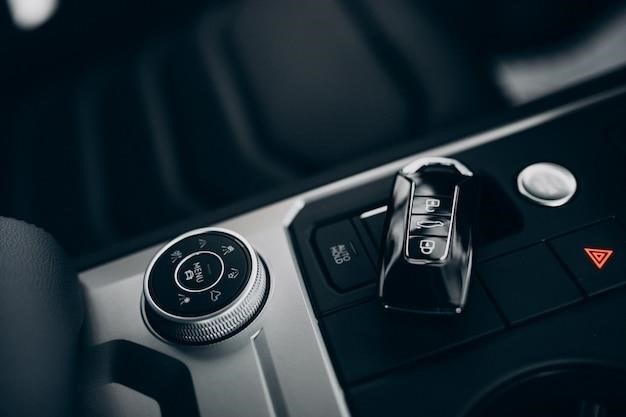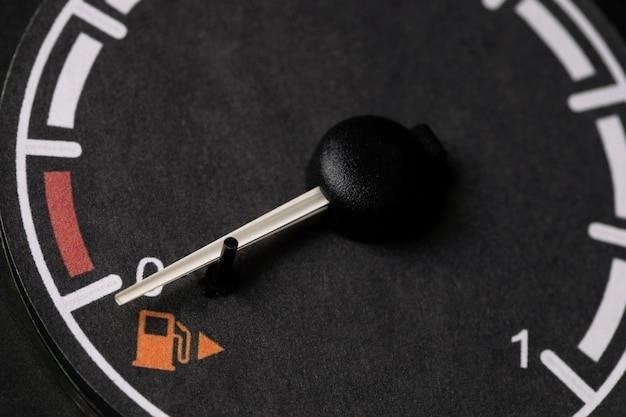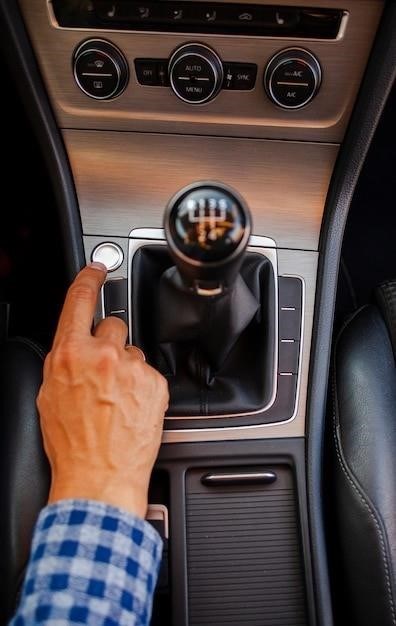The 3-Speed Manual Transmission⁚ A History
The 3-speed manual transmission was a ubiquitous feature in cars throughout the mid-20th century, particularly in North America. While it was the most common transmission type in the 1940s and 1950s, the rise of more modern transmissions led to its decline. However, the 3-speed manual continues to hold a place in automotive history, with many classic cars and even some modern sports cars still featuring this simple yet effective transmission.
The Rise and Fall of the Column-Shift 3-Speed
The column-shift 3-speed manual transmission reigned supreme in North America during the 1940s and 1950s. Its simplicity and affordability made it a popular choice for manufacturers, and it became synonymous with the American automotive landscape of the era. Drivers would select gears using a lever mounted on the steering column, a design that was both convenient and cost-effective. However, as the automotive industry progressed, the limitations of the 3-speed became more apparent. The introduction of more powerful engines and higher speeds highlighted the need for a broader range of gear ratios. Furthermore, the column-shift design was increasingly seen as outdated and less ergonomic compared to floor-mounted shifters.
By the late 1950s and 1960s, the 3-speed column-shift began to lose its dominance. The rise of the 4-speed manual transmission offered better performance and fuel economy, and its floor-mounted design was gaining popularity. The column-shift 3-speed continued to be used in some vehicles, particularly those with lower performance requirements, but its reign as the primary transmission type was over. Today, the column-shift 3-speed is a relic of a bygone era, a testament to a time when simplicity and affordability were paramount in the automotive world.
The Last 3-On-The-Tree Cars in North America
While the floor-shifted 3-speed manual transmission persisted for a longer period, the column-shift version, affectionately known as “3-on-the-tree,” had a more definitive end in North America. The last new car offered with a 3-on-the-tree was the 1979 Chevrolet Nova, a model that was also available with its Oldsmobile and Pontiac twins. This marked the end of an era for a transmission type that had been a staple of American driving for over three decades.
However, the 3-on-the-tree wasn’t completely extinct. It continued to be available in trucks for a few more years, with the 1987 Chevrolet C10 pickup being the last model to offer this transmission option. After that, the 3-on-the-tree officially went out of production in North America, leaving behind a legacy of simplicity, affordability, and a distinct driving experience that defined a significant chapter in automotive history.
The 3-Speed Manual’s Place in Modern Cars
While the 3-speed manual transmission is largely a relic of the past in the modern automotive landscape, it still finds a niche in certain segments of the market. While not common, some modern sports cars still offer a 6-speed manual transmission as an option, appealing to enthusiasts who value the driving experience and the connection it provides. This is particularly true for cars like the BMW M2, which offers a 6-speed manual as a standard feature, proving that there is still a market for this type of transmission.
The appeal of the manual transmission, even in a modern world dominated by automatics, lies in its engagement and control. Drivers appreciate the feeling of being directly connected to the car, the ability to precisely control the engine speed, and the satisfaction of shifting gears themselves. For many, the manual transmission is more than just a way to get from point A to point B; it’s a way to experience the car’s full potential and enjoy the driving process.

The Mechanics of the 3-Speed Manual Transmission
The 3-speed manual transmission is a relatively simple system that allows the driver to manually select gears, connecting the engine to the wheels through a series of gears and shafts.
Shift Pattern and Gear Ratios
The 3-speed manual transmission typically follows a simple “H” pattern for shifting. First gear is located in the lower left corner, second gear in the upper right, and third gear in the lower right. Reverse gear is usually engaged by moving the shifter to the upper left position and then pushing it forward into a gate. The specific location of the reverse gate can vary between manufacturers and models.
The gear ratios in a 3-speed manual transmission are designed to provide a balance between acceleration and top speed. First gear is the lowest gear, providing maximum torque for starting and accelerating from a standstill. Second gear offers a balance between acceleration and speed, while third gear is the highest gear, allowing the engine to run at a lower RPM for fuel efficiency and top speed.
Clutch Operation
The clutch is a crucial component in a 3-speed manual transmission, acting as a link between the engine and the transmission. When the clutch pedal is depressed, the clutch disengages, allowing the driver to shift gears without causing damage to the transmission. When the clutch pedal is released, the clutch engages, transferring power from the engine to the transmission and ultimately to the wheels.
The clutch operation involves a series of components, including the clutch pedal, clutch lever, clutch release bearing, clutch disc, pressure plate, and flywheel. When the clutch pedal is pressed, the clutch lever moves, which in turn causes the release bearing to push against the pressure plate. This action disengages the pressure plate from the clutch disc, allowing the transmission to shift gears. When the clutch pedal is released, the pressure plate re-engages the clutch disc, transmitting power to the transmission.
The 3-Speed Manual’s Advantages and Disadvantages
While the 3-speed manual transmission has its place in history, its advantages and disadvantages make it less desirable in modern vehicles.
Advantages
The 3-speed manual transmission offers several advantages, particularly in its simplicity and affordability. Its basic design makes it less prone to complex issues, often leading to greater reliability and ease of maintenance. The fewer parts involved in its operation result in a more straightforward and cost-effective repair process. Moreover, the 3-speed manual transmission’s inherent simplicity contributes to its lighter weight, which can benefit fuel efficiency and overall performance, especially in smaller vehicles. The 3-speed manual also provides drivers with a more direct connection to the vehicle’s powertrain, allowing for a greater sense of control and engagement. This heightened driver involvement can enhance the overall driving experience, making it more enjoyable for enthusiasts who appreciate the tactile feedback and manual control. While the 3-speed manual may not be as sophisticated as modern transmissions, its straightforward design and inherent advantages make it a valuable and enduring part of automotive history.
Disadvantages
The 3-speed manual transmission, while simple and reliable, has several drawbacks that ultimately contributed to its decline in popularity. The limited number of gears restricts the vehicle’s ability to efficiently utilize engine power across a wide range of speeds. This can result in a less comfortable driving experience, especially on highways or when accelerating from low speeds. Furthermore, the lack of overdrive gears can lead to higher engine RPMs at highway speeds, contributing to increased fuel consumption. The 3-speed manual also suffers from poor fuel economy compared to modern transmissions with more gears, especially during city driving. The driver’s constant need to shift gears can be tedious and tiring, especially during prolonged driving. This can be particularly challenging in stop-and-go traffic or on winding roads. The 3-speed manual’s inability to smoothly transition between gears can lead to a less refined driving experience, particularly in modern vehicles that prioritize comfort and refinement.

Notable Vehicles with 3-Speed Manual Transmissions
The 3-speed manual transmission was once a common feature in a wide variety of vehicles, from classic American cars to modern sports cars.
Classic American Cars
Classic American cars from the 1940s, 1950s, and 1960s were often equipped with 3-speed manual transmissions. These transmissions were typically column-shifted, with the gear selector lever located on the steering column. Some popular examples of classic American cars that featured 3-speed manuals include the Chevrolet Bel Air, Ford Fairlane, and Plymouth Fury. The 3-speed manual transmission was a simple and reliable design that suited the driving conditions of the time. It offered sufficient power for everyday driving and was relatively inexpensive to manufacture and maintain.
While the 3-speed manual transmission may seem antiquated by today’s standards, it holds a special place in the hearts of many classic car enthusiasts. Its simplicity and ruggedness, combined with the nostalgic appeal of its association with vintage American cars, make it a desirable feature for collectors and restorers.
Modern Sports Cars
While the 3-speed manual transmission is primarily associated with older vehicles, a few modern sports cars still offer this option, albeit in a more refined form. The 2024 BMW M2, for instance, is available with a six-speed manual transmission, providing a more engaging driving experience for enthusiasts. The appeal of a 3-speed manual in a modern sports car lies in its simplicity and directness. It offers a more intimate connection between the driver and the vehicle, allowing for a more deliberate and precise control of the car’s power delivery.
The manual transmission also provides a greater sense of involvement and engagement, particularly for those who enjoy the tactile experience of shifting gears. The ability to manually select gears allows drivers to optimize the car’s performance for different driving scenarios. While the 3-speed manual may not be as common as it once was, its presence in modern sports cars demonstrates that there’s still a market for this classic technology, particularly for those who appreciate the driving experience it offers.
The Future of the 3-Speed Manual Transmission
The future of the 3-speed manual transmission remains uncertain. While it holds a nostalgic appeal for some, its practicality and efficiency are challenged by the advancements in automatic transmissions. However, the manual transmission’s inherent simplicity and directness continue to attract a dedicated following.
The Shift Towards Automatic Transmissions
The rise of automatic transmissions in the 1960s and 1970s marked the beginning of the decline of the 3-speed manual. These automatic transmissions offered greater convenience and smoother driving experiences, particularly in stop-and-go traffic. Additionally, the development of fuel-efficient overdrive automatic transmissions further solidified their dominance. As fuel prices soared during the energy crises of the 1970s, the fuel efficiency of automatics became even more appealing. This trend continued throughout the 1980s and 1990s, with automatic transmissions becoming the standard in most vehicles. By the early 2000s, the 3-speed manual had become a rarity, even in the American market where it had once been the norm.
The Appeal of the Manual Transmission in a Modern World
Despite the prevalence of automatic transmissions, the manual transmission continues to hold a strong appeal for many drivers. Enthusiasts appreciate the greater control and engagement that manual shifting offers, allowing them to connect with the driving experience in a way that automatics simply cannot. The act of shifting gears provides a more engaging and rewarding driving experience, particularly for those who enjoy spirited driving. Additionally, manual transmissions are often considered more efficient, especially in terms of fuel economy, as they allow for more precise control over engine speed. While the 3-speed manual may be a relic of the past, the appeal of the manual transmission itself remains strong in the modern world, with many manufacturers continuing to offer manual options in their performance cars and sports cars.

Leave a Reply